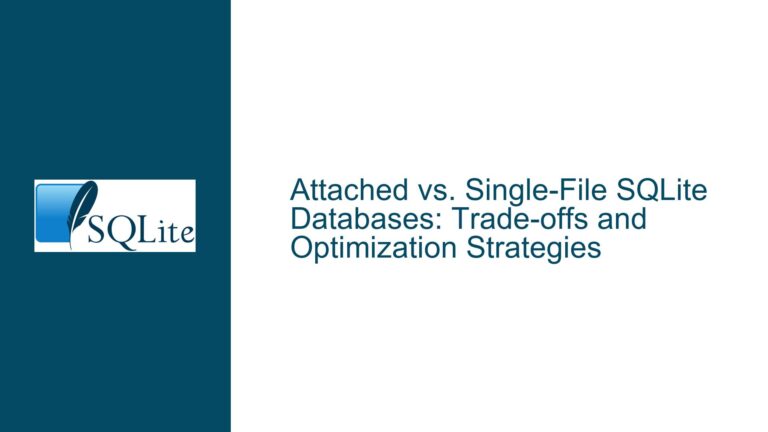Designing a Secure and Scalable SQLite Database for User-Centric Sales Platforms with Product Image Management
Issue Overview: Structuring a Relational Database for User Accounts, Product Listings, and Image Storage While Preventing Accidental Data Loss
The core challenge involves creating a SQLite database schema that manages three critical entities: user accounts, product listings, and product images. The system must prevent accidental mass data deletion when users modify their accounts while accommodating complex relationships between these entities. Key requirements include:
- User Identity Preservation: User deletion should not automatically erase associated product records if business logic requires historical data retention
- Image Storage Strategy: Handling product photos through either binary BLOB storage or external file references
- Referential Integrity: Ensuring foreign key relationships between users/products and products/images without creating cascading deletion risks
- Scalability Considerations: Designing tables to handle potential future features like order histories, inventory tracking, and supplier relationships
The database must balance normalization principles with practical performance considerations. A poorly designed schema could lead to:
- Orphaned product records when users delete accounts
- Bloated database files from unoptimized image storage
- Inconsistent product-image relationships
- Inability to enforce business rules at the database level
Possible Causes: Foreign Key Misconfiguration, Normalization Errors, and Storage Anti-Patterns
1. Cascading Deletion Through Improper Foreign Key Constraints
The default behavior of SQLite’s FOREIGN KEY clause with ON DELETE CASCADE can permanently remove child records when parent records are deleted. While useful in some contexts, this becomes dangerous when:
- Users control record deletion capabilities
- Business requirements mandate historical data preservation
- Multiple foreign key relationships exist between tables
Example dangerous schema:
CREATE TABLE products (
id INTEGER PRIMARY KEY,
user_id INTEGER REFERENCES users(id) ON DELETE CASCADE,
image_id INTEGER REFERENCES product_images(id) ON DELETE CASCADE
);
Deleting a user would cascade through both products and associated images.
2. Denormalized Data Storage in Single Table Designs
Attempting to store users, products, and images in a single table leads to:
- Data duplication (multiple user entries for each product)
- Update anomalies when modifying user details
- Difficulty maintaining image-product relationships
- Exponential growth in table size from repeated BLOB storage
Example anti-pattern:
CREATE TABLE all_data (
user_id INTEGER,
product_name TEXT,
product_image BLOB
);
3. Inefficient BLOB Handling Strategies
Storing images directly as BLOBs without consideration for:
- SQLite’s maximum BLOB size (2GB theoretically, but practical limits much lower)
- Database file inflation from binary storage
- Slow performance when retrieving large binary objects
- Lack of image metadata (resolution, format, creation date)
4. Missing Foreign Key Enforcement
SQLite doesn’t enforce foreign key constraints unless explicitly enabled via:
PRAGMA foreign_keys = ON;
Leading to silent failures when:
- Inserting products with non-existent user_ids
- Creating orphaned images not linked to valid products
- Breaking referential integrity through application code errors
5. Transaction Management Neglect
Without proper transaction boundaries, partial updates can leave the database in inconsistent states:
- User deleted but associated products remain
- Images uploaded without corresponding product entries
- Interleaved write operations causing race conditions
Troubleshooting Steps, Solutions & Fixes: Implementing a Robust Schema with Controlled Deletion and Optimized Image Storage
Step 1: Core Table Structure with Safe Foreign Key Relationships
Users Table (Base Entity)
CREATE TABLE users (
id INTEGER PRIMARY KEY AUTOINCREMENT,
username TEXT NOT NULL UNIQUE COLLATE NOCASE,
email TEXT NOT NULL UNIQUE CHECK(email LIKE '%_@__%.__%'),
created_at DATETIME DEFAULT CURRENT_TIMESTAMP,
is_active BOOLEAN DEFAULT 1 CHECK(is_active IN (0,1))
);
Products Table (User-Dependent Entity)
CREATE TABLE products (
id INTEGER PRIMARY KEY AUTOINCREMENT,
user_id INTEGER NOT NULL,
sku TEXT NOT NULL UNIQUE COLLATE NOCASE,
name TEXT NOT NULL CHECK(LENGTH(name) BETWEEN 1 AND 255),
description TEXT CHECK(LENGTH(description) <= 2000),
listed_at DATETIME DEFAULT CURRENT_TIMESTAMP,
is_available BOOLEAN DEFAULT 1 CHECK(is_available IN (0,1)),
FOREIGN KEY (user_id)
REFERENCES users(id)
ON DELETE RESTRICT
ON UPDATE CASCADE
);
Product Images Table (Optional Child Entity)
CREATE TABLE product_images (
id INTEGER PRIMARY KEY AUTOINCREMENT,
product_id INTEGER NOT NULL,
image_path TEXT NOT NULL UNIQUE CHECK(LENGTH(image_path) <= 512),
caption TEXT CHECK(LENGTH(caption) <= 255),
sort_order INTEGER DEFAULT 0 CHECK(sort_order >= 0),
FOREIGN KEY (product_id)
REFERENCES products(id)
ON DELETE CASCADE
ON UPDATE CASCADE
);
Key Design Decisions:
ON DELETE RESTRICTon products.user_id prevents user deletion while they have active product listingsON DELETE CASCADEon product_images.product_id ensures images are removed when parent product is deleted- Natural deletion order enforced through application logic: Remove images → Remove products → Remove user
- String length constraints prevent database bloat from oversized text fields
- Case-insensitive collation for username/SKU fields enables case-insensitive lookups
- Explicit boolean checks instead of SQLite’s loose truthy/falsy handling
Step 2: Image Storage Strategy Implementation
Option A: External File Storage with Metadata Tracking
CREATE TABLE product_images (
-- ... other fields ...
file_name TEXT NOT NULL CHECK(LENGTH(file_name) <= 255),
file_size INTEGER CHECK(file_size BETWEEN 1 AND 10485760), -- 10MB limit
mime_type TEXT NOT NULL CHECK(mime_type IN ('image/jpeg','image/png','image/webp')),
storage_path TEXT NOT NULL CHECK(storage_path GLOB '*/images/*')
);
Advantages:
- Database remains lean and fast for queries
- Easier integration with CDNs and image processing pipelines
- Simplified backups (database + image directory)
- Better version control through file naming conventions
Option B: Internal BLOB Storage for Small-Scale Systems
CREATE TABLE product_images (
-- ... other fields ...
image_data BLOB NOT NULL CHECK(LENGTH(image_data) BETWEEN 1 AND 1048576) -- 1MB limit
);
Hybrid Approach for Audit Logging:
CREATE TABLE image_versions (
id INTEGER PRIMARY KEY AUTOINCREMENT,
product_image_id INTEGER NOT NULL,
image_data BLOB,
created_at DATETIME DEFAULT CURRENT_TIMESTAMP,
FOREIGN KEY (product_image_id)
REFERENCES product_images(id)
ON DELETE CASCADE
);
Performance Considerations:
- Use
sqlite3_blob_open()API for streaming large BLOBs - Store thumbnails in database while keeping originals on disk
- Implement application-level caching for frequently accessed images
- Consider separate database connection for BLOB-heavy operations
Step 3: Deletion Workflow Implementation
Soft Delete Pattern for Data Retention
ALTER TABLE users ADD COLUMN deleted_at DATETIME DEFAULT NULL;
CREATE TRIGGER soft_delete_user
INSTEAD OF DELETE ON users_view
BEGIN
UPDATE users
SET is_active = 0, deleted_at = CURRENT_TIMESTAMP
WHERE id = OLD.id;
END;
Cascade Soft Delete Through Products
CREATE TRIGGER propagate_user_soft_delete
AFTER UPDATE OF deleted_at ON users
WHEN NEW.deleted_at IS NOT NULL
BEGIN
UPDATE products
SET is_available = 0
WHERE user_id = NEW.id;
END;
Hard Delete Maintenance Process
DELETE FROM product_images
WHERE product_id IN (
SELECT id FROM products
WHERE user_id IN (
SELECT id FROM users
WHERE deleted_at < DATE('now','-1 year')
)
);
Step 4: Transaction Management and Concurrency Control
Atomic User Deletion Workflow
BEGIN TRANSACTION;
-- Check for existing products
SELECT COUNT(*) FROM products WHERE user_id = ? AND is_available = 1;
-- If no active products, proceed
DELETE FROM users WHERE id = ?;
-- Application logic checks row count changes
COMMIT;
Optimistic Concurrency Control Pattern
CREATE TABLE products (
-- ... existing fields ...
version INTEGER NOT NULL DEFAULT 0
);
-- Application code
UPDATE products
SET price = ?, version = version + 1
WHERE id = ? AND version = ?;
Locking Hierarchy Implementation
- Acquire user lock
- Acquire product locks in sorted order
- Acquire image locks
- Perform operations
- Release locks in reverse order
Step 5: Advanced Referential Integrity Patterns
Cross-Table Constraint for Image Requirements
CREATE TRIGGER enforce_minimum_images
AFTER INSERT ON products
BEGIN
SELECT
CASE WHEN NOT EXISTS (
SELECT 1 FROM product_images
WHERE product_id = NEW.id
) THEN
RAISE(ABORT, 'Product must have at least one image')
END;
END;
Temporal Foreign Keys for Historical Data
CREATE TABLE product_audit (
product_id INTEGER NOT NULL,
valid_from DATETIME NOT NULL,
valid_until DATETIME DEFAULT '9999-12-31',
FOREIGN KEY (product_id) REFERENCES products(id)
);
CREATE VIEW current_products AS
SELECT * FROM products p
JOIN product_audit a ON p.id = a.product_id
WHERE CURRENT_TIMESTAMP BETWEEN a.valid_from AND a.valid_until;
Step 6: Security and Access Control Implementation
Column-Level Encryption Pattern
CREATE TABLE users (
-- ... existing fields ...
ssn TEXT NOT NULL
CHECK(ssn = sqlite_crypt(ssn, 'aes-256-cbc', 'encryption_key'))
);
Row-Level Security Using Views
CREATE VIEW user_products AS
SELECT * FROM products
WHERE user_id = CURRENT_USER_ID(); -- Application-defined function
REVOKE ALL ON products FROM sales_role;
GRANT SELECT, INSERT ON user_products TO sales_role;
Audit Logging Implementation
CREATE TABLE deletion_log (
id INTEGER PRIMARY KEY,
table_name TEXT NOT NULL,
record_id INTEGER NOT NULL,
deleted_by TEXT NOT NULL,
deleted_at DATETIME DEFAULT CURRENT_TIMESTAMP,
backup_data TEXT NOT NULL
);
CREATE TRIGGER log_user_deletion
BEFORE DELETE ON users
BEGIN
INSERT INTO deletion_log(table_name, record_id, deleted_by, backup_data)
VALUES ('users', OLD.id, CURRENT_USER, JSON_OBJECT(
'username', OLD.username,
'email', OLD.email
));
END;
Step 7: Performance Optimization Techniques
Indexing Strategy
CREATE INDEX idx_products_user ON products(user_id);
CREATE INDEX idx_images_product ON product_images(product_id);
CREATE INDEX idx_users_active ON users(is_active) WHERE is_active = 1;
Partial Index for Active Products
CREATE INDEX idx_active_products
ON products(sku, name)
WHERE is_available = 1;
Materialized View Pattern
CREATE TABLE product_summary (
user_id INTEGER PRIMARY KEY,
product_count INTEGER,
last_listed DATETIME
);
CREATE TRIGGER update_summary_insert
AFTER INSERT ON products
BEGIN
INSERT OR REPLACE INTO product_summary
SELECT
user_id,
COUNT(*),
MAX(listed_at)
FROM products
WHERE user_id = NEW.user_id;
END;
Step 8: Backup and Disaster Recovery Implementation
Online Backup API Usage
/* C code example */
sqlite3_backup_init(dest_db, "main", source_db, "main");
sqlite3_backup_step(pBackup, -1);
sqlite3_backup_finish(pBackup);
Differential Backup Strategy
ATTACH DATABASE 'backup.db' AS backup;
INSERT INTO backup.products SELECT * FROM main.products
WHERE listed_at > (SELECT MAX(listed_at) FROM backup.products);
Export Script for Critical Data
.once backup_products.sql
.dump products
.once backup_users.csv
.headers on
.mode csv
SELECT * FROM users WHERE is_active = 1;
Step 9: Testing and Validation Procedures
Unit Test Template
BEGIN TEST "User deletion with active products should fail";
INSERT INTO users (username, email) VALUES ('testuser', '[email protected]');
INSERT INTO products (user_id, sku, name) VALUES (last_insert_rowid(), 'TEST', 'Test Product');
BEGIN TRANSACTION;
DELETE FROM users WHERE username = 'testuser';
ROLLBACK; -- Expected to fail due to ON DELETE RESTRICT
SELECT RAISE(FAIL, 'Test passed') WHERE NOT EXISTS (
SELECT 1 FROM users WHERE username = 'testuser'
);
END TEST;
Concurrency Stress Test
-- Process A
BEGIN IMMEDIATE;
UPDATE products SET stock = stock - 1 WHERE id = 1;
COMMIT;
-- Process B (parallel execution)
BEGIN IMMEDIATE;
UPDATE products SET stock = stock - 1 WHERE id = 1;
COMMIT;
Performance Benchmarking
EXPLAIN QUERY PLAN
SELECT p.*, u.username
FROM products p
JOIN users u ON p.user_id = u.id
WHERE u.is_active = 1 AND p.is_available = 1;
Step 10: Documentation and Maintenance Planning
Schema Documentation Template
-- Tables
SELECT name, sql FROM sqlite_schema WHERE type = 'table';
-- Triggers
SELECT name, sql FROM sqlite_schema WHERE type = 'trigger';
-- Indexes
SELECT name, tbl_name, sql FROM sqlite_schema WHERE type = 'index';
Vacuum Scheduling
PRAGMA auto_vacuum = INCREMENTAL; -- Enable in database creation
-- Weekly maintenance
PRAGMA incremental_vacuum(1000); -- Pages to vacuum
Version Migration Plan
-- Migration script template
BEGIN TRANSACTION;
PRAGMA foreign_keys = OFF;
ALTER TABLE products RENAME TO products_old;
CREATE TABLE products (... new schema ...);
INSERT INTO products SELECT ... FROM products_old;
DROP TABLE products_old;
PRAGMA foreign_keys = ON;
COMMIT;
This comprehensive approach ensures the database schema meets initial requirements while providing scalability paths for future enhancements. By implementing controlled deletion workflows, optimized image storage strategies, and rigorous integrity constraints, the system maintains data consistency while supporting complex user-product relationships.






